
Thank you so much for your generous donation!
You're creating real change — your support truly matters!
Stay connected with the project you backed and with Nature Invest -- be part of the movement for a better planet.
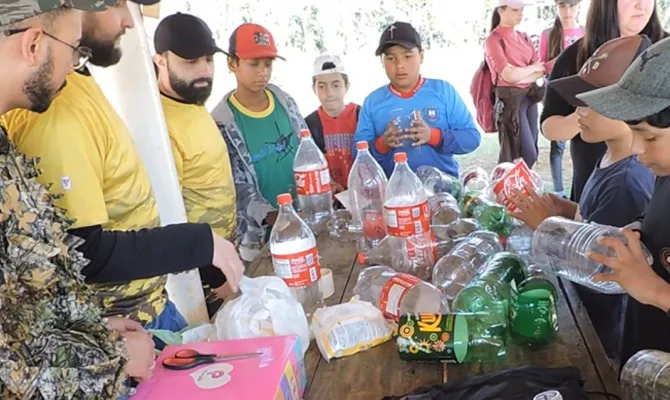
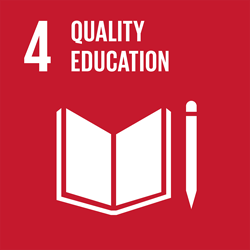


Created by, Anderson Copini
Organization Name: OSCIP GATO DO MATO
Strategic Partner: Project Not Assign
Founded on June 4, 2001, by a group of people who are aware of and committed to environmental causes, the Gato-do-Mato NGO has been promoting environmental and cultural awareness activities, as well as helping to recover degraded areas in the region surrounding the Rio do Peixe Basin. Among its most noteworthy projects is the 'Environmental Education - Rio do Peixe' action, which promoted teacher training, the distribution of booklets and other different materials on the theme of "Water and the River We Live in Every Day", which included children from the 4th grade of elementary school in Caçador and Calmon. The project also made it possible to build a contemplative trail along the banks of the River Peixe.
The Gato-do-Mato NGO has been working for 15 years in the areas of environmental education, ecology, ecotourism activities and scientific studies in Caçador and the Rio do Peixe Basin region. During this time, the institution has received the Expressão Ecologia Award (2007) in the area of Environmental Education (competing with several renowned organizations from all over southern Brazil) and the Fritz Müller Award, considered the biggest environmental award in Santa Catarina (2008), among other awards.
The institution also has the support of numerous entities in the municipality of Caçador and the region, always with the aim of developing actions aimed at environmental education and scientific studies within its area of activity. In addition, in 2021 it began an inventory of wild non-flying mammals and wild birds in the Conservation Unit in the municipality of Caçador/SC, known as FLONA.
2. BACKGROUND
The environment is constantly changing, whether due to environmental catastrophes caused by climate change, anthropogenic advances in search of non-renewable natural resources or illegal hunting of wild animals, which is a problem found in every biome in the world. To try to reduce these impacts, it is important to apply mitigating tools in schools and universities, which are environments that disseminate knowledge, and one of these tools is ongoing environmental education.
This tool is fundamental because it encourages the development of basic principles with a humanistic, holistic, democratic and participatory approach, promoting the interconnection between the natural, socio-economic and cultural environment with sustainability. The project aims to develop the cognitive side of children and teenagers and strengthen their character by raising sustainable awareness of their actions at home, at school and in society. It encourages individual actions, such as anonymously reporting illegal poachers or mistreatment of domestic animals, separating garbage at home, or afforesting backyards to minimize erosive impacts and increase the presence of wild birds. Environmental education also encourages community participation in environmental actions, such as ecological trails promoted by organizations and associations, and the formation of groups to discuss and resolve environmental issues that can have a positive impact on society.
By applying these actions, we can directly reach all students in municipal and state schools from the fourth grade up to high school, young people and children in social vulnerability and university students from the Alto Vale do Rio do Peixe University in the municipality of Caçador, where the project will be developed.
The NGO GATO DO MATO is dedicated to this issue with the aim of transforming the outlook on life for new generations. To this end, it develops activities that contribute to cognitive growth, encouraging vulnerable young people who have faced traumatic situations to join groups with similar ideals. It also proposes educational activities in the environmental field to support scholarship students and trainees in their activities.
3. GLOBAL BIODIVERSITY PLAN
GOAL 16. Ensure that people are encouraged and empowered to make sustainable consumption decisions by, among other things, establishing complementary normative, legislative and regulatory frameworks, improving education and the provision of accurate information and alternatives, and, by 2030, reducing the global ecological footprint of consumption equitably, halving global food waste, significantly reducing overconsumption, and substantially reducing waste production, so that all people can live well and in harmony with Mother Earth.
GOAL 21. Ensure that the best data, information and knowledge are available to decision-makers, professionals and the public, to guide effective and equitable governance, integrated and participatory management of biological diversity, and to improve communication, awareness, education, research and knowledge management, and also in the context that traditional knowledge, innovations, practices and technologies of indigenous peoples and local communities are only accessed with their free, prior and informed consent, in accordance with national legislation.
4. DESCRIPTION OF THE PROJECT
4.1 PROJECT DEVELOPMENT
The municipality of Caçador is located in the Upper Rio do Peixe Valley, in the Midwest of Santa Catarina and has an area of 1,009.80 km2, bordering the municipalities of Calmon, Lebon Régis, Rio das Antas, Arroio Trinta, Macieira and Água Doce, and the state of Paraná. The population of Caçador is 73,720 and its demographic density, according to IBGE (2022), is 74.96 inhabitants per square kilometer.
Considering the different divisions of the state of Santa Catarina, Caçador belongs to the Western Mesoregion and the Joaçaba Microregion. The municipality is also part of AMARP - the Association of Municipalities of the Upper Rio do Peixe Valley, along with Arroio Trinta, Macieira, Pinheiro Preto, Calmon, Rio das Antas, Fraiburgo, Salto Veloso, Ibiam, Tangará, Iomerê, Timbó Grande, Lebon Régis, Videira and Matos Costa.
Regarding the characterization of the vegetation of the municipality of Caçador as a whole, it can be said that it is characterized as Mixed Ombrophilous Forest (FOM), which represents 92.63% of the total area of the municipality, and there are also Natural Fields, which represent 7.37% of the total area. However, when the urban perimeter is taken into account, all of it is in the FOM phyto-ecological region. In 2019, the municipality of Caçador saw the publication of the National Forest Inventory (IFN) prepared at municipal level. The IFN-Caçador analyzed the total area of natural and planted forests, based on mapping data from 2014. According to this inventory, there are around 71,031 ha of forests in the municipality, divided into 41,340 ha of natural forests (42% of the territory) and 29,691 ha of planted forests (30% of the territory) (Brazilian Forest Service, 2019).
Still in relation to environmental aspects, it is worth mentioning that Caçador has an area of relevant environmental interest located in the territorial area of the Taquara Verde district. The unit refers to the Caçador National Forest - FLONA Caçador, created by Ordinance 560 of October 25, 1968. This area has great potential for the development of projects in research, conservation of natural resources and Environmental Education, involving, for example, the implementation of trails, as well as fostering historical and cultural recovery, promoting ecotourism and enabling the aggregation of residents into cooperatives or associations capable of sustainably exploiting a typical product of the region which is the seed of Araucaria angustifolia: the pine nut (ICMBio, 2023).
4.2 PROJECT BENEFICIARIES
Directly, the project will benefit all students (from 4th grade onwards) in the municipal and state schools, vulnerable young people and children and the local university, proposing an activity that can be developed in conjunction with scholarship holders and trainees from the courses offered by the local university, totaling approximately 500 people.
4.3 GENERAL OBJECTIVE
To promote environmental education for schools and universities in the municipality of Caçador through fun activities involving interaction with nature.
4.4 SPECIFIC OBJECTIVES
Specific objective 1: Present the project proposal to external partners;
Specific objective 2: Develop activities.
4.5 METHODOLOGY
The area where the activities will be carried out will be in the Forest Garden managed by the Department of Agriculture, Rural Development and the Environment, located 5 km away from the center in a native forest area, with streams and a waterfall, containing a ready-made trail with decks. The other area where the activities will take place is in the Caçador National Forest Conservation Unit, located in the Taquara Verde district, around 20 km from the center. All travel costs for those taking part in the activities, including vulnerable children and teenagers, state and municipal school students and academics, will be covered by the municipal and state education departments.
The project's technical team includes four (04) biologists, one of whom is the project coordinator and the other three (03) are part of the technical team who must take part in at least nine (09) activities over the course of the project.
Specific objective 1: Present the project proposal to external partners;
4.5.1 Meetings with partners;
The project will be presented to potential project partners, namely: the Department of Agriculture, Rural Development and the Environment, the municipal and state Department of Education, the board of the local university and ICMBio. On this occasion, the project's technical team should explain the importance of the topic, point out the materials that will be used and reinforce the partnership mainly with the Department of Agriculture, Rural Development and the Environment and ICMBio, since the activities with students and academics must be carried out in areas managed by these bodies.
4.5.2 Drawing up the timetable;
During an advance visit, together with partner agents, the schedule of activities will be drawn up, taking into account the municipal, state and academic school calendars. In this way, all the planned activities can be carried out without compromising the school curriculum.
Specific objective 2: Development of activities.
4.5.3 Development of pieces to publicize the project;
In order to publicize the activities carried out by the project, "Imprenautas - Cultura, diversão e arte" will be responsible for developing a documentary video, following all the activities from start to finish, with interviews with the beneficiaries before they took part in the EE activities and after they took part in the project. The video will be published in the "Jornal Cabloco" and should feature the name of the school, university, project funder, supporters and partners. This video will be shared on all the NGO's social networks and all those involved will be tagged in order to reach as many people as possible.
4.5.4 EE activity 1: Ecological trails;
The trails, which are already open, will be walked by all the students and academics to observe the environment they will be in. One of the trails is about 2,100 m long and is located in the Forest Garden of the Department of Agriculture, Rural Development and the Environment. The other trail that will be visited is just over 1,500 m long and is located in the Taquara Verde district of the Caçador FLONA, which belongs to ICMBio. At this point, it will be possible to observe the local endemic fauna and the native flora containing araucarias, imbuias, tree ferns, bromeliads and other species native to the region, as well as the streams and waterfalls present on the trails.
4.5.5 EE activity 2: Birdwatching;
This activity will be carried out with the aid of digital cameras, cell phones and binoculars, where a responsible researcher will indicate places to stop along the trails to observe and record the species found.
4.5.6 EE activity 3: Making plaster casts of footprints;
This activity is carried out with a researcher from the NGO who accompanies the participants along the trail, pointing out places with footprints of wild animals in the region. During the activity there will be a stop to create molds of the footprints found. Using recycled materials (such as PET bottles), scissors, notebooks, pencils and plaster, participants will make the plaster cast and record the information in the notebook. Each participant must use their own cell phone to record the activity. In addition, each participant will receive a gift, consisting of a pen and a booklet, to write down the species that left the footprint.
4.5.7 EE activity 4: Fossil excavation simulation.
This activity will require the acquisition of materials to simulate an archaeological excavation: dinosaur fossils in resin, garden pebbles, a wood carving kit, a brush and/or paintbrush, hoes, shovels and steel mesh sieves. The NGO's researchers will prepare the excavation sites by creating pits of the appropriate size for the skulls, with each skull in a specific hole. The earth removed from the holes will be sifted over the skulls and a little water will be added to harden the earth. Meanwhile, a researcher from the NGO will give a mini-lecture on dinosaurs, the science of paleontology and the process of excavating fossils. After the lecture, the groups of students and academics will be formed and allocated to the respective sites set up, with at least 5 people in each group, and each member will have a specific role. The researcher and other members of the NGO will then accompany the participants to the excavation site.
4.6 RESULTS
The general results expected from the project include the strengthening of Environmental Education through meetings with the participating organizations, in which the importance of the continued application of this approach will be discussed. The aim of these meetings is to integrate the themes worked on in the classroom with real-life practices and to stimulate a new perspective on nature. A total of five (05) meetings will be held with the participating institutions to promote a more conscious and engaged view of the environment. To engage at least 500 students in the activities proposed by the project.
In addition, the project aims to optimize and use areas that are currently little explored for environmental education activities, with the aim of increasing visibility and engagement with these spaces. To this end, 2,100-meter trails will be used in the Forest Garden of the Department of Agriculture, Rural Development and the Environment, and 1,500 meters in the ICMBio, located in the Taquara Verde District, known as FLONA Caçador, for practical activities. The aim is to revitalize these spaces and attract more visitors, promoting a richer interaction with nature.
4.7 PERFORMANCE INDICATORS
The project's performance indicators are:
- Five (05) minutes of meetings with partners, demonstrating the evolution of the organization and development of the project;
- Four (04) Environmental Education activities implemented;
- 500 students taking part in Environmental Education activities;
- 15 dissemination actions with photos/videos and publications on social networks.
4.8 ESTIMATED DURATION
The project will last 12 months.
5. MONITORING PLAN
The project will be monitored on a quarterly basis, through meetings between the project coordinators and the board of OSCIP Gato do Mato, as well as the participation of representatives from external partners, to monitor activities and update the schedule.
The information will be compiled into standardized institutional reports, which can be made available to supporters/donors who request clarification of the project, which will contain information on the execution of activities and the percentage of achievement of each planned result. All supporting documents will be shared and updated in a spreadsheet on One Drive.
6 PROJECT BUDGET
6.1 VALUE OF THE PROPOSAL
The value of the project is fifty-four thousand eight hundred and seventy-one with forty-one cents (R$ 54,871.41).
7. INSTITUTIONS INVOLVED
- OSCIP ONG GATO DO MATO;
- Secretariat for Agriculture, Rural Development and the Environment;
- Municipal Department of Education;
- State Department of Education;
- Alto Vale do Rio do Peixe University;
- ICMBio.
8. WORK PLAN
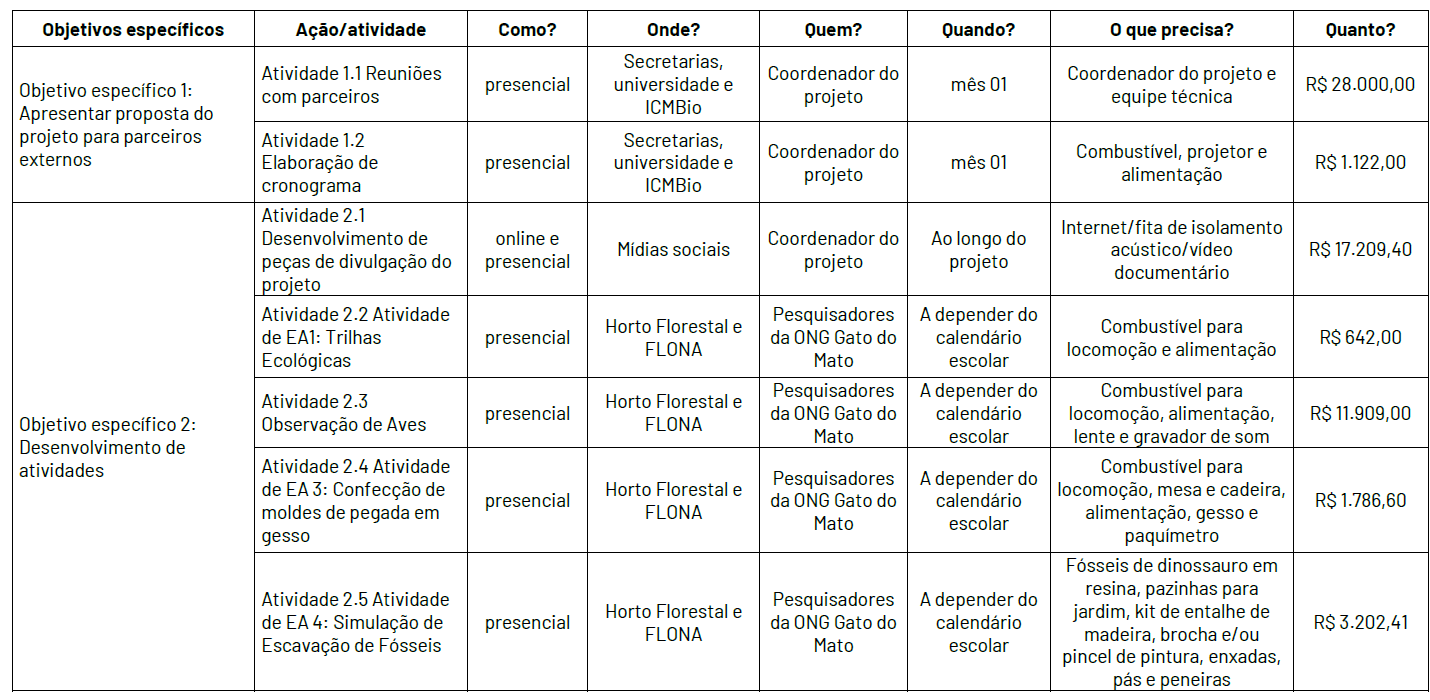
9. DETAILED BUDGET
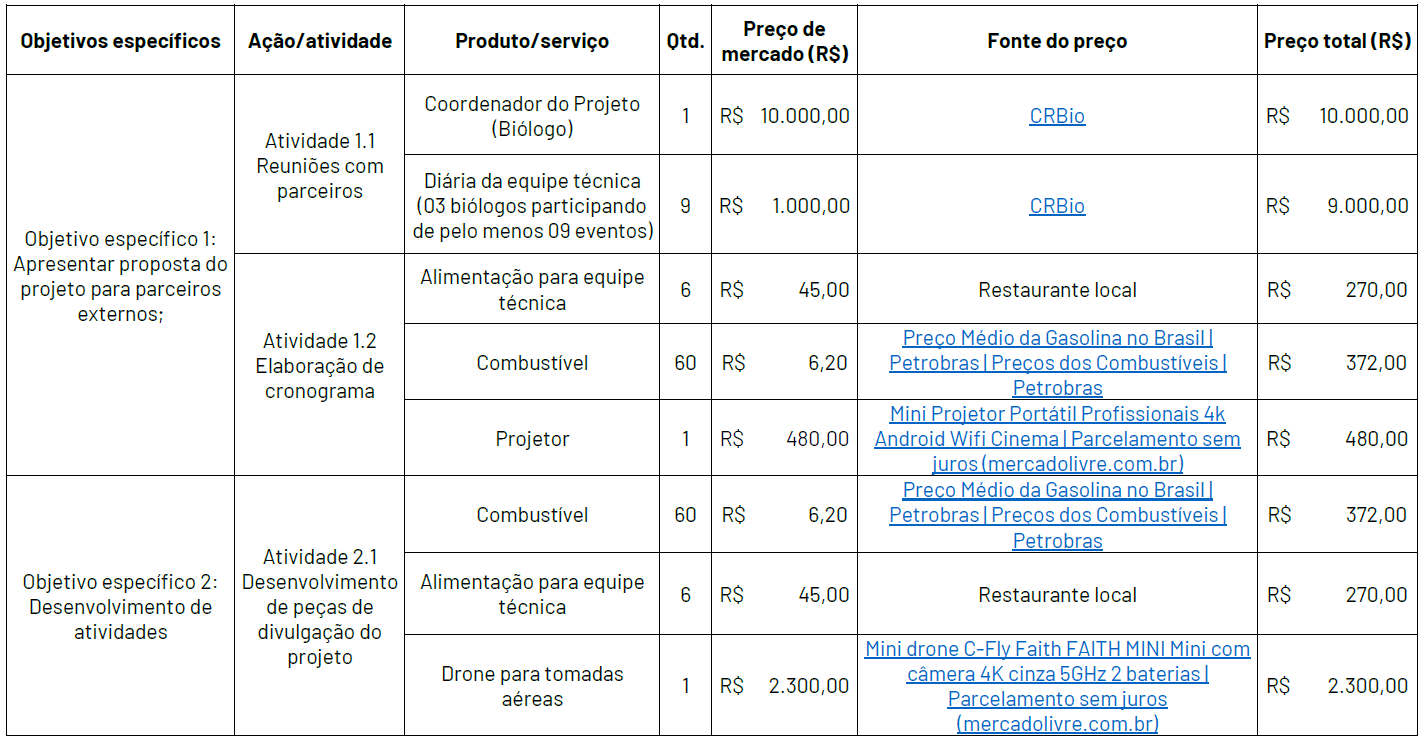
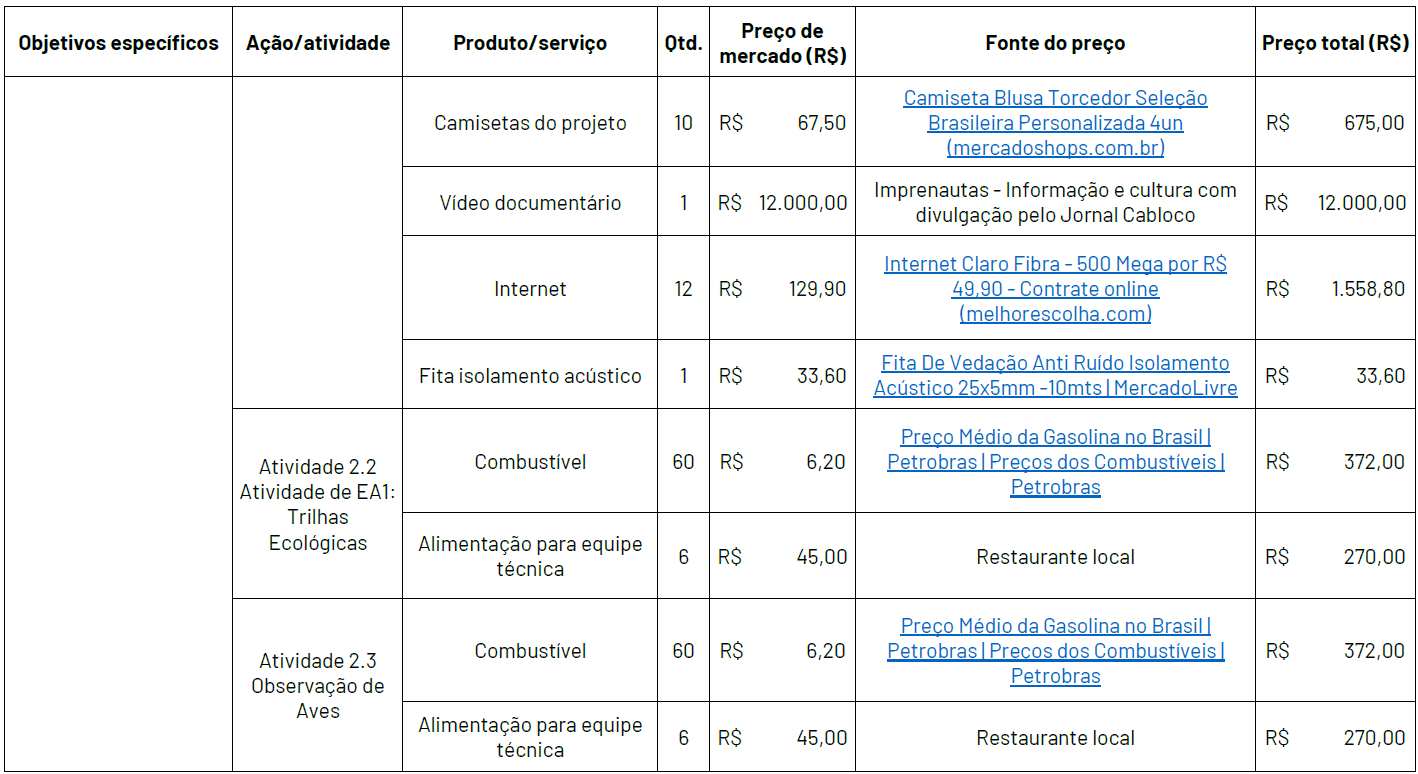
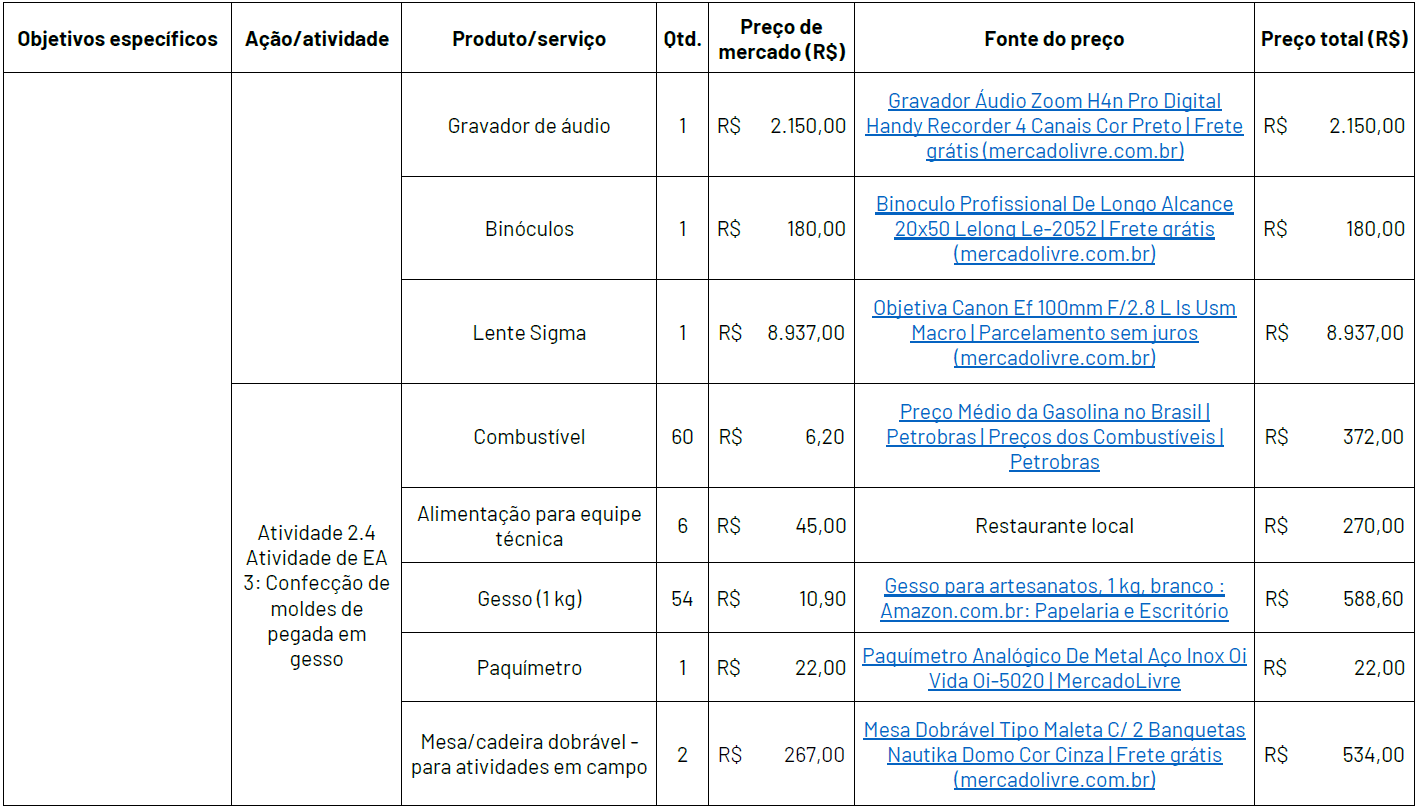
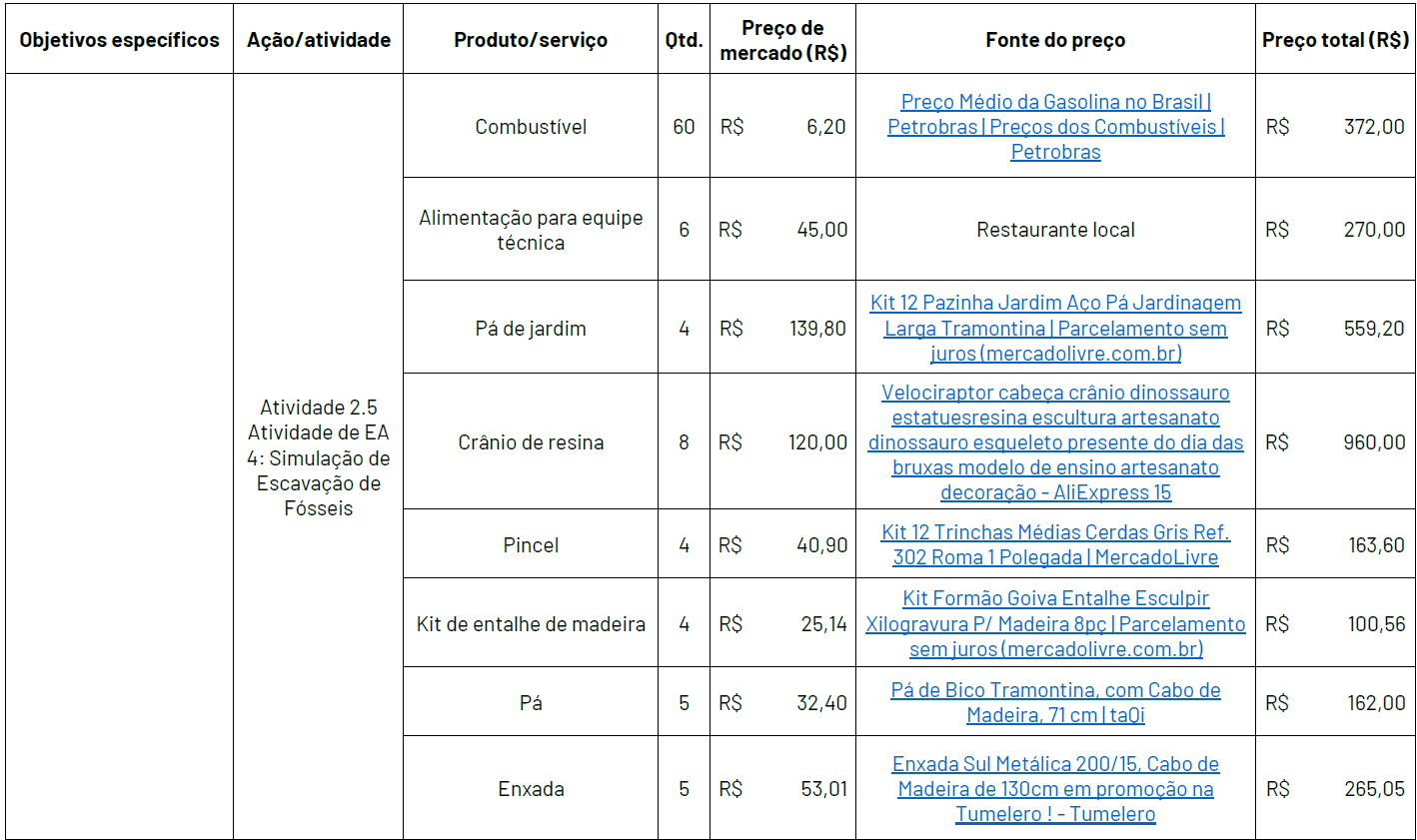

The challenge would be to promote continuing environmental education for today's society, with a view to protecting and preserving natural resources through sustainable practices.
The biggest problem today is that young people are directly connected to technology and no longer develop outdoor activities, increasing the problem of "not caring" about the nature in which they live. Applying environmental education activities ex situ, in the Caçador National Forest, will instigate the knowledge applied through the project, as well as putting young people in direct contact with nature.
With more and more young people having access to technology (video games, latest generation cell phones, computers, notebooks, tablets, etc.), according to some researchers who are child psychologists, this has decreased young people's interest in practicing physical exercise, as well as losing interest in enjoying outdoor activities (camping, guided walks, trails, adventures, etc.).
To promote environmental education for schools and universities in the municipality of Caçador through recreational activities, hikes/trails, observing wild birds, searching for wild animal footprints (identification and their characteristics) and then making a plaster cast and excavating dinosaur fossils (resin replicas), encouraging young people to search carefully and carefully for a fossil that will be buried, arousing curiosity, instigating the development of patience and discipline. In addition to interacting with nature, these would be the main objectives. All the activities can benefit normal young people and those with problems, whether attention deficit, autism or even social inclusion (vulnerability).
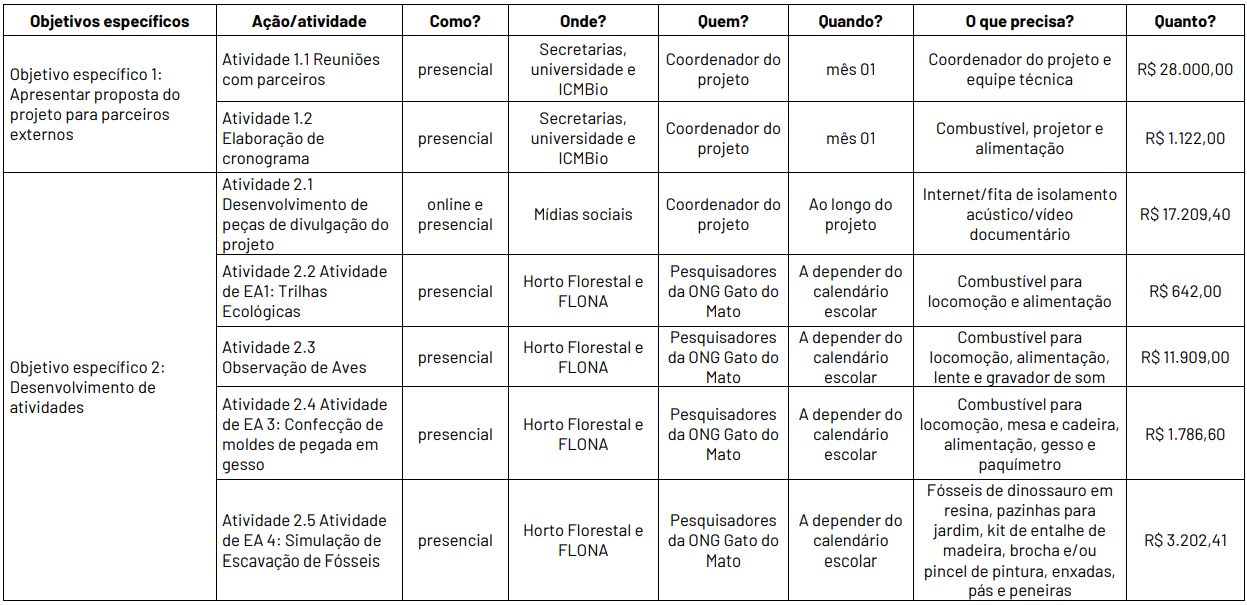
Caçador, SC, Brasil